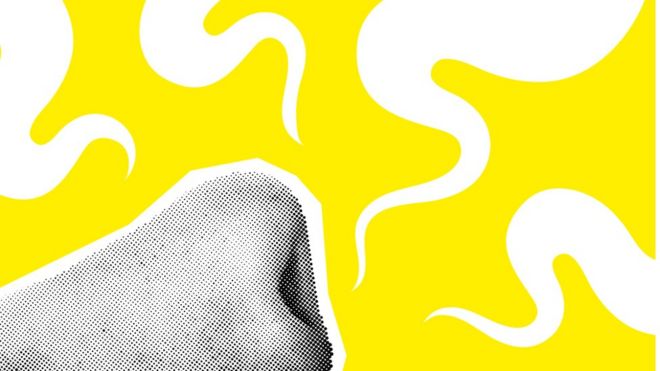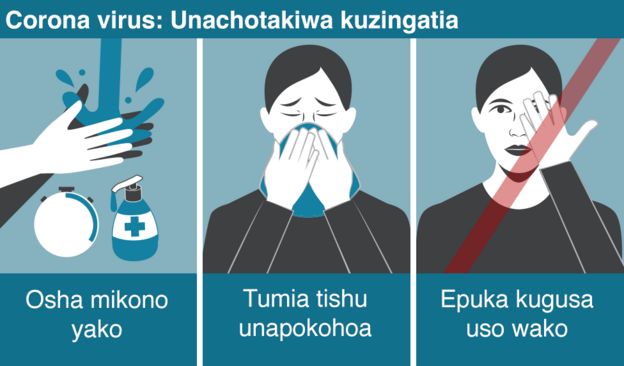shakur kimboka
JF-Expert Member
- May 11, 2013
- 268
- 357
Kama kichwa kinavyojieleza hapo zaidi ya 70% ya confirmed cases za corona virus wagonjwa walipoteza uwezo wao wakunusa na kutest ladha kabla hata ya kuanza kuumwa
===
UFAFANUZI KUTOKA KWA WATAALAMU KUHUSU DALILI HII
Je kupoteza ladha na harufu ni dalili ya coronavirus?

Kupoteza hisia ya kunusa na kuonja ladha ya chakula kunaweza kuwa dalili ya coronavirus, kulingana na watafiti nchini Uingereza.
Timu katika Chuo cha King's College London imeangazia matokeo ya watu zaidi ya 400,000 walioripoti kile walichoshuku ni virusi vya corona katika programu moja.
Lakini kupoteza hisia ya kunusa na hamu ya kula pia ni ishara ya kupata maradhi mengine ya kuambukiza kama vile homa.
Na wataalamu wanasema homa na kukohoa bado zinasalia kuwa dalili za msingi za kufuatiliwa kwa karibu na hatua kuchukuliwa.
Ikiwa wewe ama mtu mwengine unayeishi naye amepata kikohozi kinachoendelea, au kuwa na kiwango cha joto la juu, ushauri ni kusalia nyumbani ili kuepuka kusambaza virusi vya corona kwa wengine.


Utafiti huu ulibaini nini?
Watafiti kutoka King's College walitaka kukusanya taarifa kuhusu dalili ambazo huenda zinaashiria kupata virusi vya corona ili kusaidia wataalamu kupata uelewa mzuri zaidi na kukabiliana na virusi hivyo.
- Asilimia 53 ya waliohojiwa walikiri kuwa na uchovu mwingi sana
- Asilimia 29 walikuwa na kikohozi kinachoendelea
- Asilimia 28 walikuwa na matatizo ya kupumua
- Asilimia 18 walipoteza hisia zao za kunusa na kuonja ladha ya chakula
- Asilimia 10.5 walipata na homa
Miongoni mwa waliothibitishwa kuwa na maambukizi ya coronavirus asilimia 59 walipoteza uwezo wa kunusa na kuonja ladha ya chakula.
Je kupoteza hisia ya kunusa na kuonja ladha ya chakula vinastahili kuongezwa kama dalili za corona?

Wataalamu wanasema hadi kufikia sasa bado hakuna ushahidi wa kutosha kuthibitisha hilo.
Wizara ya afya Uingereza na Shirika la Afya duniani bado hawajaongeza hoja hizi miongoni mwa orodha ya dalili za corona.
Bodi inayosimamia wataalamu wa tiba ya masikio, pua na koo wanasema, sio jambo la kushangaza kuona baadhi ya wagonjwa wa Corona wakiripoti dalili hizi lakini haimaanishi kuwa zinaashiria Covid-19.
Watafiti wa King's College wanasema kupoteza hamu ya kuonja chakula na hisia ya kunusu zinaweza kuwa dalili za ziada za kufuatilia kwa karibu pengine siyo hizo tuu lakini kwa pamoja na dalili zingine kama vile kukohoa na homa.
Mkuu wa timu ya utafiti Profesa Tim Spector amesema: "Zikijumuishwa na dalili zingine, ukosefu wa hisia ya kunusa na kuonja chakula inaonekana kuwa mara tatu zaidi kwa wagonjwa waliopata Covid-19 kulingana na data yetu, na hivyo basi wanastahili kujitenga kwa siku saba kupunguza usambaaji wa virusi vya Corona."
Credit: BBC SWAHILI
===
ZAIDI SOMA HAPA
Doctors from around the world are reporting cases of patients with COVID-19, the illness caused by the coronavirus, who have lost their sense of smell, known as anosmia, or taste, known as ageusia. The director of the University of Florida’s Center for Smell and Taste and the co-director of the UF Health Smell Disorders Program answer questions about this emerging trend.
Is the loss of smell an early sign of COVID-19?
Loss of smell occurs with the common cold and other viral infections of the nose and throat. Anecdotal reports suggest the loss of smell may be one of the first symptoms of COVID-19. Doctors around the world are reporting that up to 70% of patients who test positive for the coronavirus disease COVID-19 — even those without fever, cough or other typical symptoms of the disease — are experiencing anosmia, a loss of smell, or ageusia, a loss of taste. A new study just published found that 20 of 59 patients (ages 50-74) interviewed in Italy reported a smell or taste loss.
More research is needed to understand this link, but it may provide a low-cost, practical indicator of which people should self-isolate or get further testing, depending on the symptom severity and testing availability.
What are anosmia and ageusia?
The body’s chemical senses include smell, used to detect volatile odors, and taste, which recognizes food compounds like sugars, salts and acids. A number of chemosensory disorders result in the diminishment, distortion or complete loss of smell or taste functions. For example, anosmia is the complete loss or absence of smell, while hyposmia is a reduced ability to smell. Similarly, ageusia is an absence of taste.
Approximately 13% of people over 40 years old have a significant impairment of their sense of smell. These numbers are lower for younger people, but significantly higher for the elderly. By contrast, taste loss is much less prevalent, and often results from physical damage to the taste nerves. Even so, both smell and taste disorders are quite common and can have major negative impacts on the health and quality of life of the millions affected.
According to news reports, many of the COVID-19 patients reporting a chemosensory loss describe a loss of taste. However, it is more likely that smell loss accounts for this symptom.
When we eat or drink, the brain combines our perceptions of taste from the mouth with what is known as retronasal olfaction – that is, the perception of smell that comes from odors leaving the mouth and entering the nose through the connecting passage in the throat – into what is specifically called flavor. Patients who have experienced anosmia or severe hyposmia may describe a loss of taste but are still able to detect sugar, salt or acid on the tongue. What they have lost is the contribution of smell to their perception of flavor. We would predict that in most cases, the taste loss reported by COVID-19 patients is likely due to a reduced or absent ability to smell.
Why could the coronavirus cause anosmia?
Loss of smell can result from many diverse causes such as head trauma, nasal polyps, chronic allergies, toxin exposure and neurodegenerative disease.
One of the most common causes of anosmia and hyposmia are viruses that produce upper respiratory infections, often referred to as the “common cold.”
Viruses could impact smell function in any of several ways. They could attack various cells in the nasal tissue, inducing local inflammation and disrupting odor detection. The virus could directly disable or damage the sensory cells in the nose that detect odors. Another possibility is that viruses could follow the olfactory nerve’s pathway through the skull and into the brain, where they could do additional damage. Whether this coronavirus wreaks havoc on our sense of smell by killing olfactory sensory neurons, by disrupting their function or by otherwise impacting nasal olfactory tissues remains unknown, but will certainly be an important area of investigation.
Could anosmia serve as an early indicator for COVID-19 disease?
The doctor and patient anecdotes reported recently describe a high incidence of anosmia in COVID-19 patients, including many without other symptoms. Thus, smell testing could be a useful tool to identify people who may be infected with COVID-19. Indeed, some otolaryngologists, doctors who treat diseases of the ear, nose and throat, in the United Kingdom and United States have recommended that individuals who experience a sudden loss of smell or taste should self-isolate for 14 days, and that smell testing should be integrated into COVID-19 screening protocols.
But do the facts bear this out? For example, one small study of 59 people found that 60% of patients with upper respiratory infections not related to COVID-19 had a significant reduction in their ability to smell. This might suggest that the prevalence of smell loss associated with COVID-19 is no higher than that typically experienced with the common cold.
Unfortunately, smell testing is rarely done as part of a normal doctor’s visit, so the data to resolve this is lacking. Furthermore, self-reporting of smell function can be inaccurate. It is thus critical to conduct controlled scientific studies to assess whether smell disorders such as anosmia are an indicator of a COVID-19 infection.
It will take time to conduct those studies. In the meantime, what should you do if you experience sudden smell loss? The advice from ENT UK, a professional group that represents ear, nose and throat surgeons, and the British Rhinological Society seems prudent. Self-isolate, and contact your physician for recommendations of next steps. Smell testing as part of a typical COVID-19 screen, as recommended by the American Academy of Otolaryngologists, also makes sense, even if the test is not diagnostic for COVID-19 in and of itself.
Simple scratch-and-sniff smell tests could be sent to patients to take in their home and report via secure communications, minimizing coronavirus exposure of overburdened health care providers. Along with body temperature readings and a patient history, smell testing could allow physicians to make better choices about who to prioritize for self-isolation or more specific COVID-19 testing.